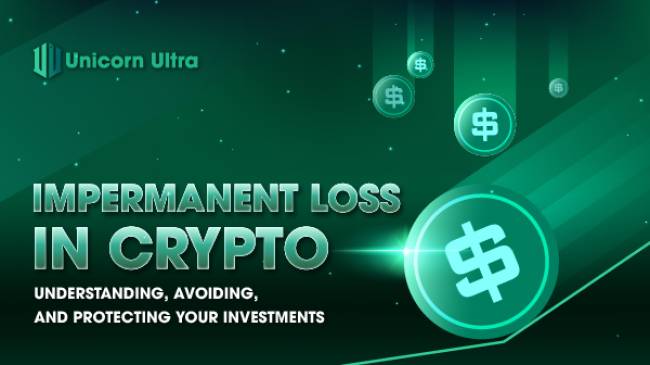Cryptocurrencies have opened up new investment opportunities, but they also come with risks. One significant risk is impermanent loss, which can affect your investments when providing liquidity on decentralized exchanges. In this blog, we will explore what is impermanent loss, the concept of impermanent loss, its occurrence, and provide tips to protect your portfolio. Let's dive into the world of impermanent loss and learn how to navigate it in the crypto market.
Table of Contents
- What is Impermanent Loss in Crypto?
- How Does Impermanent Loss Work?
- When does impermanent loss happen?
- Where does impermanent loss occur?
- Examples of impermanent loss
- How can we estimate impermanent loss?
- How to minimize Impermanent Loss?
- What strategies are there to profit from DeFi without Impermanent Loss?
- How To Avoid Impermanent Loss?
What is Impermanent Loss in Crypto?
What is impermanent loss? The world of cryptocurrencies offers exciting opportunities for investors to participate in the growing digital economy. However, with the benefits come certain risks, and one of them is impermanent loss. Impermanent loss refers to a phenomenon that occurs when providing liquidity to decentralized exchanges (DEXs) or automated market makers (AMMs) and experiencing a loss due to the price volatility of the underlying assets.

How Does Impermanent Loss Work?
To understand impermanent loss, it's essential to grasp the concept of liquidity provision on DEXs or AMMs. These platforms rely on liquidity pools where users deposit their cryptocurrency assets. These pools enable trading by providing liquidity for different token pairs.
When a user contributes funds to a liquidity pool, they receive pool tokens representing their share of the liquidity. The value of these tokens is determined by the proportional amount of each asset held in the pool. However, the value of the tokens can change due to fluctuations in the prices of the underlying assets.
Impermanent loss occurs when the value of the assets in the liquidity pool changes asymmetrically. If one asset's price increases significantly compared to the other asset, the liquidity provider will experience a loss when withdrawing their funds. This loss is considered "impermanent" because it can reverse if the price ratio returns to its original state.
When does impermanent loss happen?
Impermanent loss is most likely to occur when there is significant price volatility in the assets of a liquidity pool. It is particularly prevalent in situations where the assets have a strong correlation, yet experience different price movements. For example, if a liquidity provider deposits an equal amount of Ether (ETH) and a stablecoin like USDT, and the price of ETH rises while USDT remains stable, impermanent loss will be incurred.
Where does impermanent loss occur?
Impermanent loss is commonly observed on decentralized exchanges and automated market maker platforms. These platforms, such as Uniswap and PancakeSwap, use the constant product formula to maintain the balance of assets in their liquidity pools. This formula assumes a constant product of the token balances, meaning that when one token's price changes, the quantity of the other token adjusts accordingly.
Examples of impermanent loss
Let's consider a hypothetical example to illustrate impermanent loss. Suppose a liquidity provider adds 10 ETH and 10,000 USDT to a liquidity pool on a DEX with an initial ETH/USDT price of $2,000. If the ETH price increases to $3,000 while the USDT remains unchanged, the liquidity provider would have impermanent losses upon withdrawal. In this case, the liquidity provider's pool tokens would be worth less compared to holding the assets separately.

How can we estimate impermanent loss?
There are various methods to estimate impermanent loss, including mathematical formulas and online calculators. These tools take into account the initial and current prices of the assets, as well as the liquidity provided, to calculate the potential loss.
How to minimize Impermanent Loss?
Impermanent loss is a phenomenon specific to liquidity provision in decentralized exchanges (DEXs) or automated market maker (AMM) platforms. It occurs when the value of your assets in a liquidity pool diverges from holding those assets separately. While it is not possible to completely eliminate impermanent loss, there are strategies you can employ to minimize its impact. Here are some approaches:
- Choose Stable Assets: Consider providing liquidity for stablecoins or assets with relatively low price volatility. These assets tend to experience less significant price swings, reducing the potential for impermanent loss compared to highly volatile assets.
- Optimize Asset Pair Selection: Select asset pairs that have a similar level of volatility or are well-correlated. When the assets in a liquidity pool move in a similar manner, the impact of impermanent loss is reduced. Avoid pairing assets with vastly different price behaviors, as this increases the potential for impermanent loss.
- Provide Liquidity in Balanced Proportions: Ensure you maintain a balanced proportion of both assets in the liquidity pool. If the pool becomes imbalanced, with one asset dominating the other, the potential for impermanent loss increases. Regularly monitor and rebalance your liquidity positions to maintain the desired ratio.
- Consider Providing Liquidity in Stablecoin Pools: Providing liquidity in pools with stablecoins can minimize impermanent loss because the value of stablecoins remains relatively stable compared to other volatile assets. However, it's important to consider the interest rates or other incentives offered by stablecoin pools, as these can affect the overall profitability of providing liquidity.
- Evaluate Impermanent Loss vs. Fees: Consider the trade-off between impermanent loss and the fees earned from providing liquidity. Calculate the potential loss versus the fees earned over a specific time period to determine if providing liquidity is economically viable for you.
- Use Impermanent Loss Protection Mechanisms: Some platforms offer impermanent loss protection mechanisms, which aim to mitigate the impact of impermanent loss. These mechanisms often involve staking or providing liquidity tokens that can be redeemed for the underlying assets in the liquidity pool, compensating for any loss. Research and assess the available options and associated risks before utilizing such mechanisms.
- Periodically Assess and Adjust: Regularly monitor your liquidity positions and assess the potential impact of impermanent loss. If you find that the losses are significant or unsustainable, you may consider adjusting your liquidity provision strategy, reallocating assets, or exploring alternative investment opportunities.
It's important to note that impermanent loss is an inherent characteristic of liquidity provision and cannot be entirely eliminated. It's essential to understand the risks involved and carefully consider your risk tolerance and investment objectives before engaging in liquidity provision on DEXs or AMM platforms. Conduct thorough research, seek advice from experienced liquidity providers or experts, and stay updated with the latest developments in decentralized finance (DeFi) to make informed decisions.

What strategies are there to profit from DeFi without Impermanent Loss?
Profiting from decentralized finance (DeFi) without incurring impermanent loss can be challenging since impermanent loss is a specific risk associated with providing liquidity in liquidity pools. However, there are alternative strategies in DeFi that allow you to generate profits without directly exposing yourself to impermanent loss. Here are some strategies to consider:
- Yield Farming: Instead of providing liquidity in a liquidity pool, you can engage in yield farming. Yield farming involves leveraging different DeFi protocols to maximize your yield on specific assets. This typically involves borrowing assets from one protocol, supplying them to another protocol for generating additional returns, and then repaying the borrowed assets. By carefully managing your positions and utilizing different protocols, you can aim to generate profits without directly experiencing impermanent loss.
- Staking: Some DeFi projects offer staking opportunities where you can lock up your assets in a smart contract and earn staking rewards. Staking allows you to participate in network consensus or governance, and potentially earn rewards in the form of additional tokens or fees. By staking your assets, you can generate returns without the risk of impermanent loss associated with liquidity provision.
- Lending and Borrowing: Participating in lending and borrowing activities within DeFi platforms can be another way to generate profits. By lending your assets to other users, you can earn interest on your holdings. Similarly, borrowing assets and leveraging them for other investment opportunities can yield profits. This strategy focuses on earning interest and taking advantage of the borrowing/lending market rather than liquidity provision.
- Liquidity Mining: Some DeFi projects offer liquidity mining programs where users can earn additional tokens as rewards for providing liquidity in specific pools. While impermanent loss is still a risk in liquidity provision, the additional rewards from liquidity mining can potentially offset or outweigh the impermanent loss.
- Token Investment: Instead of actively providing liquidity or engaging in specific DeFi strategies, you can choose to invest in tokens of promising DeFi projects. Conduct thorough research and due diligence to identify projects with strong fundamentals, innovative technology, and potential for long-term growth. By investing in tokens early or when they are undervalued, you can aim to generate profits through capital appreciation.
- DeFi Index Funds: Consider investing in DeFi index funds or diversified portfolios that offer exposure to multiple DeFi projects. These funds are managed by professionals who allocate investments across various DeFi assets, aiming to capture the overall growth of the DeFi market. By diversifying your investments, you can mitigate the risks associated with impermanent loss and focus on the broader growth of the DeFi sector.
Remember, no investment strategy is entirely risk-free, and it's crucial to assess the risks, conduct thorough research, and consider your risk tolerance and investment objectives before participating in DeFi activities. Stay informed about the latest developments in the DeFi space and seek advice from professionals or experts in the field.
How To Avoid Impermanent Loss?
While impermanent loss cannot be completely eliminated, there are strategies to mitigate its impact:
- Diversify your liquidity provision: Instead of depositing assets with a high correlation, consider providing liquidity for different token pairs. This diversification can help reduce the chances of incurring significant impermanent losses.
- Choose stablecoins or pegged assets: By providing liquidity for stablecoins or pegged assets, you can minimize the risk of impermanent loss, as these tokens tend to have less price volatility compared to other cryptocurrencies.
- Monitor market conditions: Stay informed about the market conditions and the correlation between different assets. Understanding potential risks and volatility can help you make informed decisions when providing liquidity.
- Active management: Consider actively managing your liquidity provision by rebalancing your assets based on market movements. This approach involves monitoring the price ratio of the assets in the liquidity pool and adjusting the allocation accordingly.
- Impermanent loss insurance: Some DeFi protocols offer impermanent loss insurance, where users can protect their investments against potential losses. These insurance options can provide an additional layer of security for liquidity providers.
In conclusion, impermanent loss is an inherent risk when providing liquidity on decentralized exchanges and automated market maker platforms. Understanding what is impermanent loss, how it works, when and where it occurs, and employing mitigation strategies can help you navigate this challenge effectively. By making informed decisions and diversifying your liquidity provision, you can safeguard your investments and potentially enhance your overall returns in the volatile world of crypto trading. Follow https://uniultra.xyz/ for more blockchain updates.






